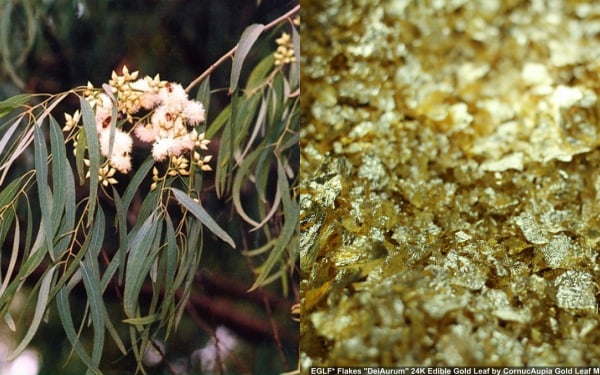Eucalyptus trees, a familiar sight across Vietnam’s diverse landscapes, have an astonishing ability to “draw gold” from the earth and store it in their leaves. It sounds incredible, but this discovery has sent shockwaves through the mineral exploration industry. Meet the wondrous Eucalyptus marginata, a potential “biological gold detector” with applications beyond paper and medicine.
A Special Ability: Eucalyptus Trees Can Draw Gold from the Earth
Eucalyptus marginata, commonly known as the Eucalyptus tree, has long been cultivated in Vietnam and other tropical countries due to its rapid growth, ease of care, and adaptability to various soil conditions. However, a study by Australia’s Commonwealth Scientific and Industrial Research Organisation (CSIRO) uncovered a fascinating fact: Eucalyptus leaves contain tiny gold particles.

Scientists discovered that Eucalyptus roots can penetrate up to 40 meters deep into the ground in search of water and minerals. In the process, if the trees are planted above gold-bearing veins, they can absorb minute gold particles and transport them up into the trunk, where they accumulate in the leaves and branches.
Gold Prospecting with Plants
This discovery introduces a novel approach to mineral exploration, termed “biogeochemical prospecting.” Instead of drilling deep into the earth or using costly machinery, geologists can now analyze tree leaves to detect signs of underground gold deposits.
Even in a greenhouse experiment, where Eucalyptus trees were grown in gold-infused sand, the leaves exhibited gold crystals, proving that the gold was not merely adhered from the external environment but was indeed absorbed by the tree.
How Much Gold Is in Eucalyptus Leaves?
While intriguing, the amount of gold in each leaf is minuscule. Estimates suggest that the gold content in the leaves is approximately 46 parts per billion, equivalent to 0.000005% of the leaf’s weight. According to scientists, leaves from at least 500 Eucalyptus trees would need to be collected to yield enough gold for a small ring. Therefore, direct gold extraction from the leaves is impractical.
However, from a practical application perspective, this method offers an environmentally friendly, cost-effective, and incredibly useful solution for the initial exploration phase, helping identify potential areas before large-scale mining operations commence.
Real-World Application
In 2019, Marmota, a company in South Australia, successfully employed the leaf analysis technique in their geological surveys and stumbled upon a 6-meter-thick gold vein containing 3.4 grams of gold per ton of rock, at a depth of 44 meters. This discovery not only validated the method’s applicability but also opened new avenues for the mining industry.

Beyond Gold: The Medical and Economic Value of Eucalyptus
Apart from its remarkable gold-absorbing capability, the Eucalyptus tree is renowned for its essential oil, which finds multiple applications in medicine, including:
- Pain relief and anti-inflammatory properties
- Reducing stress and promoting relaxation
- Boosting the immune system and aiding in the treatment of colds
- Serving as a popular ingredient in steam inhalation products, essential oils, and medicated plasters
Additionally, Eucalyptus wood is a crucial resource for paper production, furniture manufacturing, and construction.
While it is not feasible to extract gold by concentrating Eucalyptus leaves, utilizing these trees to detect gold deposits offers an innovative, cost-effective, and eco-friendly solution. This method is especially valuable in areas with challenging terrain or where preliminary surveys with low costs are required. In the future, Eucalyptus trees may not just be a familiar sight in our daily lives but also a powerful tool for geologists, helping humanity sustainably and efficiently “draw gold from nature.”

































